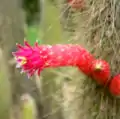| Cleistocactus hyalacanthus | |
|---|---|
 | |
| Scientific classification | |
| Kingdom: | Plantae |
| Clade: | Tracheophytes |
| Clade: | Angiosperms |
| Clade: | Eudicots |
| Order: | Caryophyllales |
| Family: | Cactaceae |
| Subfamily: | Cactoideae |
| Genus: | Cleistocactus |
| Species: | C. hyalacanthus |
| Binomial name | |
| Cleistocactus hyalacanthus | |
| Synonyms | |
|
List
| |
Cleistocactus hyalacanthus is a species of columnar cacti in the genus Cleistocactus. The name comes from the Greek kleistos meaning closed because the flowers hardly open.
Description
Cleistocactus hyalacanthus grows as a shrub with erect shoots that branch out from the base and reach heights of up to 1 meter with a diameter of 4 to 6 centimeters with about 20 ribs. The approximately 3 central spines are brown to yellowish and up to 3 centimeters long. The 20 to 30 unequal fine radial spines are bristly and whitish. Flowers sprout from the center of needle clusters. They first appear as small dark spots, which gradually enlarge over a week or ten days into purple-pink flowers are 3.5 to 4 centimeters long, each of which is only open, and only slightly, for one day. Their bracts are spread out. They are food for hummingbirds, which are attracted by the vivid red color. Those flowers that have been fertilized will develop a fruit. The spherical fruits are light greenish to brick-red fruits reach a diameter of about 1 centimeter and contain white flesh. The fruits eventually turn yellow when they are ripe. They are food for larger birds, which disperse the small black seeds in their droppings.
 Plant
Plant Spines
Spines single Flower
single Flower Blooming
Blooming Crested Plant
Crested Plant
Description
Cleistocactus hyalacanthus is distributed in the Argentinian provinces of Salta and Jujuy at altitudes of 1500 to 3500 meters and possibly in southern Bolivia.
Taxonomy
This species was first described as Cereus hyalacanthus was made in 1897 by Karl Moritz Schumann.[3] Robert Roland-Gosselin placed the species in the genus Cleistocactus in 1904.
In the IUCN Red List of Threatened Species, the species is listed as "Least Concern (LC)".[1]
References
- 1 2 "The IUCN Red List of Threatened Species". IUCN Red List of Threatened Species. 2010-09-23. Retrieved 2023-08-08.
- ↑ "Cleistocactus hyalacanthus (K.Schum.) Rol.-Goss". The Plant List (2010). Version 1. Retrieved 1 December 2012.
- ↑ Schumann, Karl Moritz; Hirscht, Karl. (1899). Gesamtbeschreibung der Kakteen (Monographia cactacearum) /von Karl Schumann. Neudamm [Dębno, Poland?]: J. Neumann. doi:10.5962/bhl.title.10394.
External links
 Media related to Cleistocactus hyalacanthus at Wikimedia Commons
Media related to Cleistocactus hyalacanthus at Wikimedia Commons Data related to Cleistocactus hyalacanthus at Wikispecies
Data related to Cleistocactus hyalacanthus at Wikispecies
